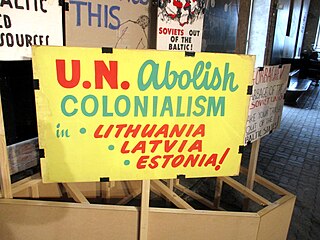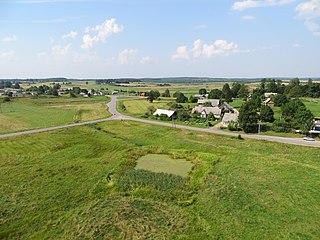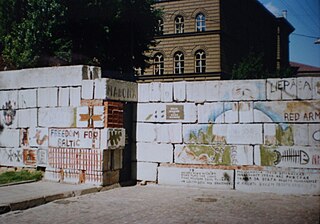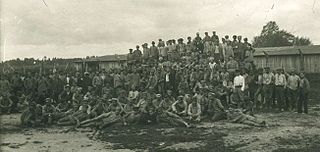
The Singing Revolution was a series of events in 1987–1991 that led to the restoration of independence of the three Soviet-occupied Baltic countries of Estonia, Latvia, and Lithuania at the end of the Cold War. The term was coined by an Estonian activist and artist, Heinz Valk, in an article published a week after the 10–11 June 1988 spontaneous mass evening singing demonstrations at the Tallinn Song Festival Grounds.

The three independent Baltic countries – Estonia, Latvia, and Lithuania – were invaded and occupied in June 1940 by the Soviet Union, under the leadership of Stalin and auspices of the Molotov–Ribbentrop Pact that had been signed between Nazi Germany and the Soviet Union in August 1939, immediately before the outbreak of World War II. The three countries were then annexed into the Soviet Union in August 1940. The United States and most other Western countries never recognised this incorporation, considering it illegal. On 22 June 1941, Nazi Germany attacked the Soviet Union and within weeks occupied the Baltic territories. In July 1941, the Third Reich incorporated the Baltic territory into its Reichskommissariat Ostland. As a result of the Red Army's Baltic Offensive of 1944, the Soviet Union recaptured most of the Baltic states and trapped the remaining German forces in the Courland Pocket until their formal surrender in May 1945.

Artūras Zuokas is a Lithuanian politician. He is the Chairman of the political party Lithuanian Freedom Union. He was the Mayor of Vilnius from 2000 to 2007 and again from 2011 to 2015. From 2008 to 2009 he was a member of the Seimas.

Irena Degutienė is a Lithuanian politician and member of the conservative Homeland Union. She is currently the Deputy Speaker of Seimas, and was twice the acting Prime Minister of Lithuania, first from 4 May 1999 to 18 May 1999 and then from 27 October 1999 to 3 November 1999. She has also been the Speaker of Seimas from 15 September 2009 to 14 September 2012, as well as Minister for Social Security and Labour from 1996 to 2000. In 1978, she graduated from Vilnius University with a degree in medicine. For almost twenty years, she worked in Vilnius Red Cross Hospital before becoming a secretary in the Ministry of Health in 1994. She was initially elected to Seimas in 1996. Degutienė is the first woman to be Speaker of Seimas in Lithuania's history.
The Coup of the Volunteers was a stand-off that occurred in summer 1993 in Lithuania near Kaunas between a group of about 150 men from the Lithuanian National Defence Volunteer Forces and the Lithuanian government. There was mutual distrust between SKAT and the newly elected leftist Democratic Labour Party of Lithuania (LDDP). Several SKAT members abandoned their posts, took their arms, and retreated to a wooded area near Kaunas in July and August 1993. The crisis escalated when the government issued an order for the volunteers to secure their weapons at designated locations in September. Interpreting the order as confiscation of their weapons, a total of about 150 armed men gathered near Riogliškiai. They expressed their mistrust and dissatisfaction with the new LDDP government and raised social and political demands. After a week long negotiations, the men agreed to return to their posts if no one would be persecuted for their role in the coup.

The January Events were a series of violent confrontations between the civilian population of Lithuania, supporting independence, and the Soviet Armed Forces. The events took place between 11 and 13 January 1991, after the restoration of independence by Lithuania. As a result of the Soviet military actions, 14 civilians were killed and over 140 were injured. 13 January, was the most violent day. The events were primarily centered in the capital city Vilnius, but Soviet military activity and confrontations also occurred elsewhere in the country, including Alytus, Šiauliai, Varėna and Kaunas.

Medininkai is a village in Lithuania. Administrationwise it is centre to the Medininkai Eldership, which forms part of the Vilnius District Municipality; the district itself is in turn part of the Vilnius County. Beginnings of the village are related to the 14th century. The local castle was among the key ones in the Grand Duchy of Lithuania; in 1387, upon christening of the country, the grand duke Jogaila founded one of the first 7 churches here. Medininkai enjoyed its golden era in the late 15th century. In the early modern period the settlement reached the status of a town, but it failed to develop into a major urban centre. Over time the place was losing importance, and at the turn of the 19th and 20th centuries it was reduced to a village. The area has retained its traditionally rural character, though during recent decades it started to host transport and spedition businesses, related to the nearby Lithuania-Belarus border crossing at the Vilnius-Minsk highway. Since the early 21st century Medininkai is home to a major compound which educates border-control officials. The place enjoys some appeal among tourists; visitors are attracted by ruins of the castle, now turned into a museum, and the highest natural point in Lithuania, named Aukštojas. The village and the eldership are populated mostly by members of the Polish national minority.

The State Border Guard Service or VSAT is a border control institution under the Ministry of the Interior charged with controlling and maintaining the security of the Lithuanian borders on land, in the Baltic Sea and the Curonian Lagoon. VSAT is a member of the EU Frontex and is responsible for the security of about 1,070 kilometres (660 mi) of the external border of the European Union with Kaliningrad Oblast and Belarus.
Medininkai is a village in Lithuania.

The Barricades were a series of confrontations between the Republic of Latvia and the Union of Soviet Socialist Republics in January 1991 which took place mainly in Riga. The events are named for the popular effort of building and protecting barricades from 13 January until about 27 January. Latvia, which had declared restoration of independence from the Soviet Union a year earlier, anticipated that the Soviet Union might attempt to regain control over the country by force.

The Lithuanian–Soviet War or Lithuanian–Bolshevik War was fought between newly independent Lithuania and the Russian Socialist Federative Soviet Republic in the aftermath of World War I. It was part of the larger Soviet westward offensive of 1918–1919. The offensive followed the retreat of German troops and sought to establish Soviet republics in Ukraine, Belarus, Lithuania, Latvia, Estonia, Poland and link up with the German Revolution. By the end of December 1918 Soviet forces reached Lithuanian borders. Largely unopposed, they occupied one town after another and by the end of January 1919 controlled about two thirds of the Lithuanian territory. In February, the Soviet advance was stopped by Lithuanian and German volunteers, who prevented the Soviets from capturing Kaunas, the temporary capital of Lithuania. From April 1919, the Lithuanian war went parallel with the Polish–Soviet War. Poland had territorial claims over Lithuania, especially the Vilnius Region; these tensions spilt over into the Polish–Lithuanian War.

Dainius Kreivys is a Lithuanian businessman and politician who served as the Minister of Economy of Lithuania from 2008 to 2011 and is a member of Seimas since 2012. He is a member of the conservative political party Homeland Union – Lithuanian Christian Democrats.

The three Baltic states – Estonia, Latvia and Lithuania – were re-occupied in 1944–1945 by the Soviet Union (USSR) following the German occupation. The Baltic states regained independence in 1990–1991.
Tomas Šernas is a former Lithuanian customs officer and the only survivor of the Medininkai Massacre on 31 July 1991. He survived the point-blank shot to his head, but became disabled. After extensive medical treatment and rehabilitation, Šernas graduated from theological studies at Klaipėda University and joined the Reformed churches as a parson of the Vilnius parish. In 2010, he was elected for a three-year term as the General Superintendent of the Evangelical Reformed Church of Lithuania.

IKI Lietuva, formerly known as Palink, is the operator of the "IKI" supermarket chain and the "LastMile" delivery service in Lithuania.
The Diplomatic Service of the Republic of Lithuania is the part of the governmental service tasked with enforcing the foreign policy set by the President, the Parliament, and the Government of the Republic of Lithuania. The head of the service is the Foreign Minister.
The 1990 October Revolution Parade was the last parade commemorating the 1917 October Revolution during the Soviet Union's existence. It celebrated the 73rd anniversary of the revolution.

The Soviet economic blockade of Lithuania was imposed by the Soviet Union on Lithuania between 18 April and 2 July 1990.
Valentinas Laskys was a Lithuanian serial killer who, together with his daughter, robbed and killed four people. He was executed by shooting for these crimes.
Kazys Jonaitis, known as The Roadside Maniac, is a Lithuanian serial killer and rapist who was convicted of killing at least three women in 2001, a few years after being released from a prior murder conviction. For his latter crimes, he was sentenced to life imprisonment.














